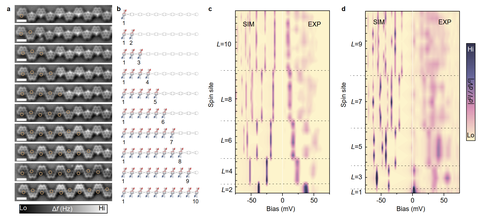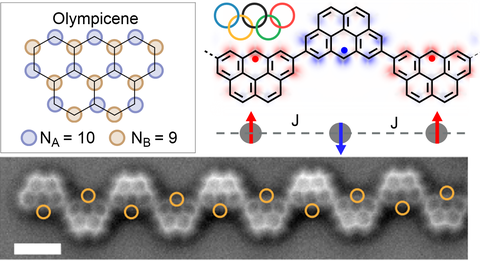Mar 14, 2025
Spin excitations in olympicene-based antiferromagnetic spin-1/2 Heisenberg chains
In one-dimensional quantum magnets, strong quantum fluctuations prevent spontaneous symmetry breaking, leading to the formation of quantum-disordered many-body states such as resonating valence bond states. Half-integer spin chains are expected to exhibit a gapless excitation spectrum in the thermal dynamic limit, with the elemental excitations comprising at least two fractional spin-½ with well-defined energy-momentum relation, known as spinons. In finite length, confinement effects introduce a quantization gap, which gradually approaches zero as the chain length increases (L→∞). Despite the theoretical appeal, the experimental realization of the isotropic spin-½ Heisenberg model faces significant challenges. Furthermore, the lack of access to well-defined finite chains hampers systematic studies on how spin excitations evolve with chain length and how even- and odd-numbered chains exhibit distinct behaviors.

Figure 1. Structural illustration of a sublattice-resolved olympicene monomer and chemical structure of the covalently linked olympicene radical chain
Scientists from MPI Halle, TU Dresden, the International Iberian Nanotechnology Laboratory (INL), and the Swiss Federal Laboratories for Materials Science and Technology (EMPA) have covalently linked specifically designed open-shell nanographenes, known as Olympicenes, into chains on an Au(111) surface to establish an isotropic spin-1/2 Heisenberg chain (Figure 1). We achieve unprecedented experimental control over such spin chains by characterizing and manipulating the spin degrees of freedom of individual chain spin sites using the tip of a scanning probe microscope. This approach allows precise, unit-by-unit tuning of the chain length, ranging from dimers to chains with up to 50 units. Additionally, the spin excitations of these chains are probed using inelastic electron tunneling spectroscopy (IETS), complemented by high-level theoretical calculations (Figure 2). Importantly, the exchange interaction in this system is as large as 38 meV. The power-law decay of spin excitations with chain length indicates quasi-long-range spin-spin correlations, a characteristic feature of a gapless 1D spin liquid phase. The longest chain with 50 units shows "V-shaped" excitation spectra, reflecting the closing of the excitation gap. Furthermore, the ground state of odd-numbered chains is a wave-packet of a one-spinon state, whose amplitude modulation across the chain is reflected in the zero bias IETS conductance.

Figure 2. Spin excitations in short chains. a and b, nc-AFM images and the corresponding schematic illustrations of selectively activated spin chains, respectively. c and d, Spatially-resolved color map of spin spectral weight (|d2I/dV2|) obtained at each spin site (brown circles) of chains with even (L =2, 4, 6, 8, 10) and odd (L =1, 3, 5, 7, 9) lengths.
This work demonstrates that theoretical models of quantum physics can be realized using NGs to experimentally test their predictions. It not only opens doors in quantum technologies based on NGs but also inspires us to picture other molecules for achieving different models. Additionally, another Heisenberg model has been experimentally achieved via NGs design in a study that is shortly to be published.
Acknowledgements: This work was supported by the Swiss National Science Foundation (grant nos. 212875 (R.F.), CRSII5_205987 (P.R. and J.F.-R.), MARVEL no. 205602 (C.A.P.)), ERC Consolidator grant (T2DCP, grant no. 819698 (X.F.)), H2020-EU.1.2.2.-FET Proactive Grant (LIGHT-CAP, 101017821 (X.F.)), the European Union (grant FUNLAYERS-101079184 (J.F.-R. and X.F.)), Fundação para a Ciência e a Tecnologia (grant no. PTDC/FIS-MAC/2045/2021 (J.F.-R.)), Generalitat Valenciana (grants nos. Prometeo2021/017 (J.F.-R.), MFA/2022/045 (J.F.-R.) and CIACIF/2021/434 (M.F.-C.)), MICIN-Spain (grant nos. PID2019-109539GB-C41 and PID2022-141712NB-C22 (J.F.-R.)), the Advanced Materials programme supported by MCIN with funding from European Union NextGenerationEU (PRTR-C17.I1 (J.F.-R.)), the National Natural Science Foundation of China (no. 92463307 (J.M.)) and the Swiss National Supercomputing Centre (CSCS s1267 (C.A.P.)). We also greatly appreciate financial support from the Werner Siemens Foundation (CarboQuant (R.F.)).

